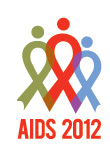 A nucleoside reverse transcriptase inhibitor (NRTI)-sparing regimen containing Selzentry (maraviroc) and Norvir (ritonavir)-boosted Reyataz (atazanavir) has roughly comparable efficacy—with some possible safety advantages—compared with a standard regimen consisting of Norvir-boosted Reyataz plus Truvada (tenofovir and emtricitabine) in first-time HIV treatment takers. This is the conclusion of a 96-week Phase II study reported Tuesday, July 24, at the XIX International AIDS Conference (AIDS 2012) in Washington, DC.
A nucleoside reverse transcriptase inhibitor (NRTI)-sparing regimen containing Selzentry (maraviroc) and Norvir (ritonavir)-boosted Reyataz (atazanavir) has roughly comparable efficacy—with some possible safety advantages—compared with a standard regimen consisting of Norvir-boosted Reyataz plus Truvada (tenofovir and emtricitabine) in first-time HIV treatment takers. This is the conclusion of a 96-week Phase II study reported Tuesday, July 24, at the XIX International AIDS Conference (AIDS 2012) in Washington, DC.
Though Selzentry is only approved for treatment-experienced people living with HIV, the entry inhibitor has been eyed as a potentially useful component of first-line treatment regimens, notably because it targets virus utilizing the CCR5 receptor on CD4 cells (as opposed to the CXCR4 receptor), which is more common in early HIV disease.
The study reported in Washington, DC, by Anthony Mills, MD, a private physician and researcher based in Los Angeles, enrolled 121 people living with HIV—all had CCR5-targeting, or “tropic,” virus—to receive Norvir-boosted Reyataz with either Selzentry (150 milligrams once a day) or Truvada.
The average age of volunteers at study entry was 37; roughly 90 percent were male and approximately three-quarters were white. The average baseline CD4 count was 350 and the average baseline viral load was 55,000 copies; roughly 20 percent had viral loads in excess of 100,000 copies.
After 96 weeks of treatment, 67.8 percent of those in the Selzentry group, compared with 82 percent in the Truvada group, had undetectable viral loads (less than 50 copies). Whether this difference between the two groups was statistically meaningful was not reported by Mills.
Using a less sensitive definition of “undetectable”—a viral load below 400 copies—the difference between the two groups was less apparent. Here, 78 percent of those in the Selzentry group, compared with 83.6 percent of those in the Truvada group, had virus that couldn’t be detected.
Virologic failure—defined as a minimal viral load change during the first four weeks of therapy, a viral load that failed to go below 400 copies by the 24th week of treatment or a viral load rebound that exceeded 1,000 copies during two consecutive clinic visits—occurred in three Selzentry-treated patients and two Truvada-treated patients.
Mills noted that six of the eight patients in the Selzentry group who had viral loads above 50 copies at week 96 still had levels below 400; several of whom had similar instances of low-level viremia during previous visits. This finding, he said, may reflect poor adherence. Whether this indicates that the NRTI-free, Selzentry-inclusive regimen is less “forgiving” of missed treatment doses than the Truvada-inclusive regimen isn’t clear.
CD4 counts increased, on average, by 264 cells in the Truvada group and 240 in the Selzentry group.
Another immunologic variable studied was the level of cellular activation over time. This was based on the premise that Selzentry’s CCR5-blocking activity likely limits cellular activation and, as a result, may minimize some of the inflammation that has been linked to various non-AIDS-related complications.
According to Mills, declines in immune activation were more apparent in the Selzentry group, compared with those in the Truvada group. However, he said, the actual significance of this remains unclear.
As for safety data, two patients in the Selzentry group, compared with no patients in the Truvada group, discontinued treatment due to side effects.
Elevated bilirubin levels—a known side effect of Reyataz—occurred in approximately one-third of patients in both treatment groups. A related problem is yellowing of the skin (jaundice), occurring in roughly 17 percent of patients in the Selzentry group and 10 percent of patients in the Truvada group, a difference that can potentially be tied to the fact that Truvada decreases Reyataz concentrations and may therefore reduce its adverse effects.
Mills also noted that study volunteers in the Selzentry group were less likely to experience decreases in creatinine clearance—a marker of possible kidney toxicity—compared with those in the Truvada group.
The researchers also looked at two markers of bone metabolism. At weeks 48 and 96, declines in these markers were more pronounced among the 61 patients in the Truvada group, compared with the 60 patients in the Selzentry group.
In conclusion, while those receiving Norvir-boosted Reyataz plus Truvada appeared somewhat more likely to maintain undetectable viral loads compared with those in the Selzentry-based regimen, Mills noted that rates of virologic failure were similar in both groups. He also reiterated the finding that no cases of drug resistance were documented in either group.
As for the differences between the treatment groups in terms of immune activation and bone markers, Mills said that further investigation is required.
A larger clinical trial—an 800-person Phase III study comparing Norvir-boosted Prezista (darunavir) plus Selzentry to Truvada plus Norvir-boosted Prezista initiated in September 2011—should be large enough to more fully evaluate key differences between the regimens.
Advertisement
Advertisement
Advertisement






Comments
Comments